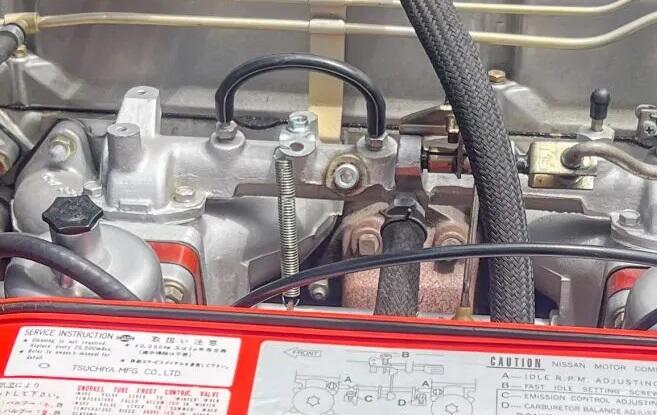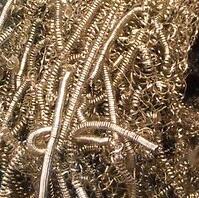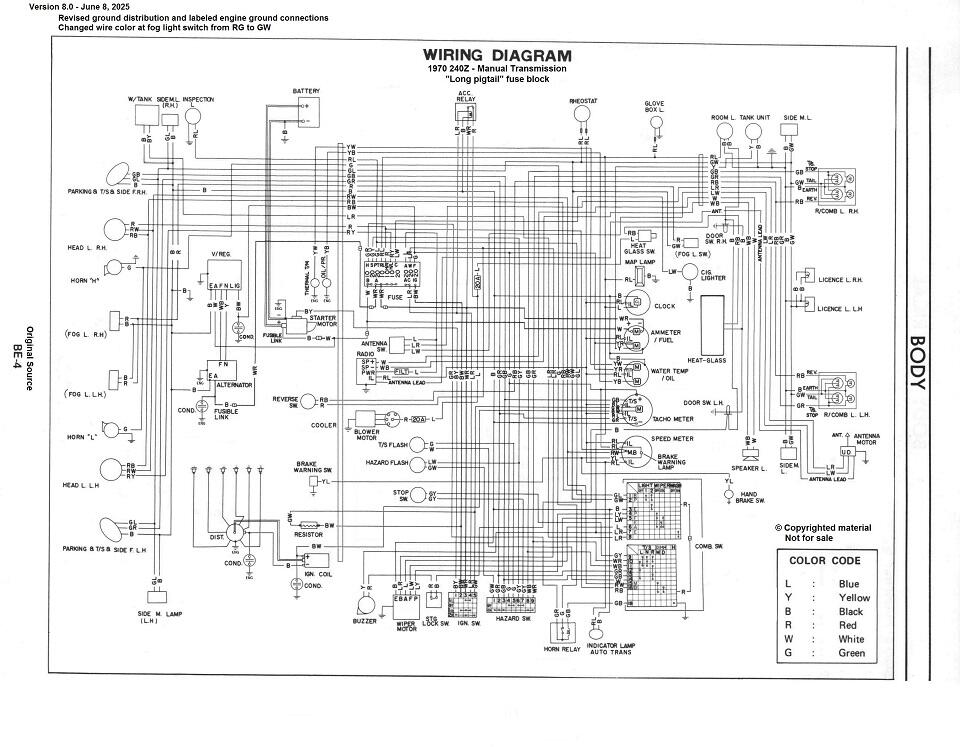Everything posted by Captain Obvious
-
rear clunking noise '76 280z
Yeah, I would start there. Remember that you need to compress the springs to the point where you could remove that center nut on the strut, just like when you are replacing strut inserts. With the springs that much compressed, you will be able to check everything in that top mount assembly. The nut tightness, the plastic spacer, the integrity of the rubber, etc. Do you have a rear sway bar? Another location that can easily produce clunk noises on small road bumps is the sway bar end links. But that's easy stuff... I assume you checked all that already.
-
1970 Wiring Diagram
Defroster switch... When did they change from the black unlit design to the yellow backlit version? Here's a hoovered pic of the unlit black: And here's the yellow backlit version: The wiring diagram I've been working on shows the simpler black unlit version. When did they change to the yellow backlighted version?
-
Early/late thermostat housings
-
Post Your Original Decal Pictures Here
-
rear clunking noise '76 280z
I doubt that hairline crack is the source of your problem, That crack probably doesn't go very deep. Hopefully it's just a surface feature. So, the first thing I would check are the nuts on the top of the strut insert (down in the recess in the top center of the strut insulators). If one of them has worked their way loose (or were never tight to begin with), you would get a noise like what you describe. And you can't just "check for play" with the strut assembly off the car. That spring will extend to take up any available play. There would only be play with a load on the strut that has partially compressed the strut insert. So was this noise always there, or is it something that has developed over time?
-
1973 240z Custom Wiring From Scratch
I haven't messed with that flasher, but I have a couple ideas... First, yes, it is completely conceivable that the electronic flasher is susceptible to polarity issues. I'd certainly make sure you have it wired with the load on the "L" pin and power on the "+" as shown in that diagram. I found a couple other pics of that flasher from other vendors, and the mounting tab is not electrically connected in any way. So forget about the below. Second, does that "two wire" flasher need to be mounted with it's tab attached to ground? In other words, is it really a three wire flasher, but they don't count the third wire because they might be making a ground connection through the mounting tab? Just some ideas.
-
Z's on BAT and other places collection
Well apparently bypassing the filter and sucking dirty air into the clean side of the air filter is a thing. Wonder how long THAT engine has been breathing dirty air. Also a whole bunch of hokey-ness going on here. ☺️ Hahaha!! :
-
If my kid gave me this I'd know he wasn't mine.
-
1973 240z Custom Wiring From Scratch
I'm guessing that you didn't see the movie..... ☺️
-
1970 Wiring Diagram
Namerow, thanks for the input, and also thanks for the work you had done previously with the wiring. Your previous work helped me with the diagram that I've been working on. So for the comments above... First, the horn. I understand the desire to have an actual switch depicted on the diagram. And in one of my earlier revisions, I actually did have one in there. But then I took it back out because I decided that I wanted to conform more closely to the original scheme depicted in the other areas of the combo switch. By that, I mean... There aren't any actual switches shown for any of the combo switch functions. Not for the headlights, the wipers... No switches for anything. Instead, "connection" is indicated by the existence of the dot. I though it would be closer to Datsun's original scheme to have a dot connection to ground when the horn is pushed. Next, the wipers. I haven't dug into that system at all, and I'm kinda hoping that I never have to. I turned mine on and the arms move, and that's hopefully all I need to know. So, with that said... Are you confident in the switch connections you have laid out? If you are sure, I'll change the diagram to what you indicate. As for the letters in the second column, I'm in the same boat as you... I think I knew at one point, but don't remember. I'll look into it. And lastly, you are correct about the change of wire colors on the combo switch side of the connectors. Problem is that situation exists all over the car. They got better with that in the diagrams for the later years, but for the early cars, the colors on the diagrams are the "colors of the harness". I'm sorry, but I'm in no position to add all the connectors for all the devices that plug into connectors and indicate the wire colors on both sides of those connectors. Haha!!! Thanks for the help!
-
1973 240z Custom Wiring From Scratch
All work and no play makes Matthew a dull boy.
-
1970 Wiring Diagram
Here's the latest wiring diagram. I changed the ground distribution scheme to add the dedicated ground strap directly from the battery terminal to the firewall, and also labeled the ground connections that are through the engine metal. Hope this helps depict how the car is actually wired. I also changed one of the wire colors leading to the fog light switch. Might only matter to people in other parts of the world who have fog lights. <V8.0> _obvious 240Z Wiring Diagram 8.0.pdf
-
Quiz Time! Water Pumps
I don't think either of those water pumps you pictured are "original", but as for "correctness", here's a couple pics from a 9/70 car. Note that this car has A/C and I don't know if that makes any difference, but it's what I got:
-
1970 Wiring Diagram
Thanks guys. I will add that dedicated wire. Even though there is a path through the alternator and you don't really "NEED" that ground strap for the system to work, I was a little uncomfortable counting on pass through the alternator case as the only way for current to get back to the negative battery terminal. Hmmm... Now how to depict that on the diagram that makes it clear... ☺️
-
1970 Wiring Diagram
The car that sold on BAT recently raised an electrical question for me about the ground distribution. On the car I'm working on, there is no dedicated ground strap going directly from the battery to the firewall, but instead, grounding to the harness (and hence the body) is done through the alternator. Then I saw that car on BAT, and there IS a dedicated connection right from the battery terminal to the firewall. Is this connection supposed to be here on the early cars? It's not "necessary" to work, but just wondering if this is how it's supposed to be:
-
Nabco vs Tokico 15/16 Brake MC Pistons
The stop screw catches the front piston like this: And the rear piston position is established by the retainer clip in the back: So the distances between those two reference locations and the "forward-most" seals on each piston is what's important. It looks like the front piston is really close, but the rear one is not. Might be "close enough", might not.
-
Nabco vs Tokico 15/16 Brake MC Pistons
That's really a risky maneuver. Overall length isn't as important as where the seals end up located when the cylinder is at rest. It would take a lot of study and investigation to know if it would work. Off the top of my head, looking at the rearmost piston (the one that the master cylinder pushes against), it has the seal in a different location than the original. The front piston is harder to analyze since it depends on where the seal will end up when the stop screw hits the lip of the piston. I'm just a guy with a keyboard, but I don't like it.
-
Wires Connected To Nothing
Good luck, and just let us know if there are still unanswered questions.
-
SN 00042 Restoration; The Older Twin
Perfect. I just couldn't see the bottom washers in the other pics. Looks great.
-
1971 HLS30-14938 "Lily" build
Yeah, I went socket head because I was thinking that getting in there with a hex driver would be easier than a phillips screw driver. And now that I've done it, I think I made the right call. T-handle allen driver for the win. Oh, and they're stainless. Seemed like the right material for the application.
-
Carb flats on float chambers
I don't know if it's the ONLY reason for it's existence (seems unlikely), but that is where they printed the identifying markings:
-
SN 00042 Restoration; The Older Twin
Here's mine. A little embarrassing to post after your clean and shiny stuff, but it's what I got. They'll work fine, but aren't as pretty. You can see the washers under the springs:
-
SN 00042 Restoration; The Older Twin
Much better. One follow up question though... Are there metal washers between the hold down springs and the shoes? I can't tell for sure from the pics, but I just want to make sure the springs are not riding directly on the shoes.
-
1971 HLS30-14938 "Lily" build
Sigh. Of course you did. Right after I did this: Yes... Before you ask. Yes, I made the little plastic washers.
- Z Parts For Sale.











